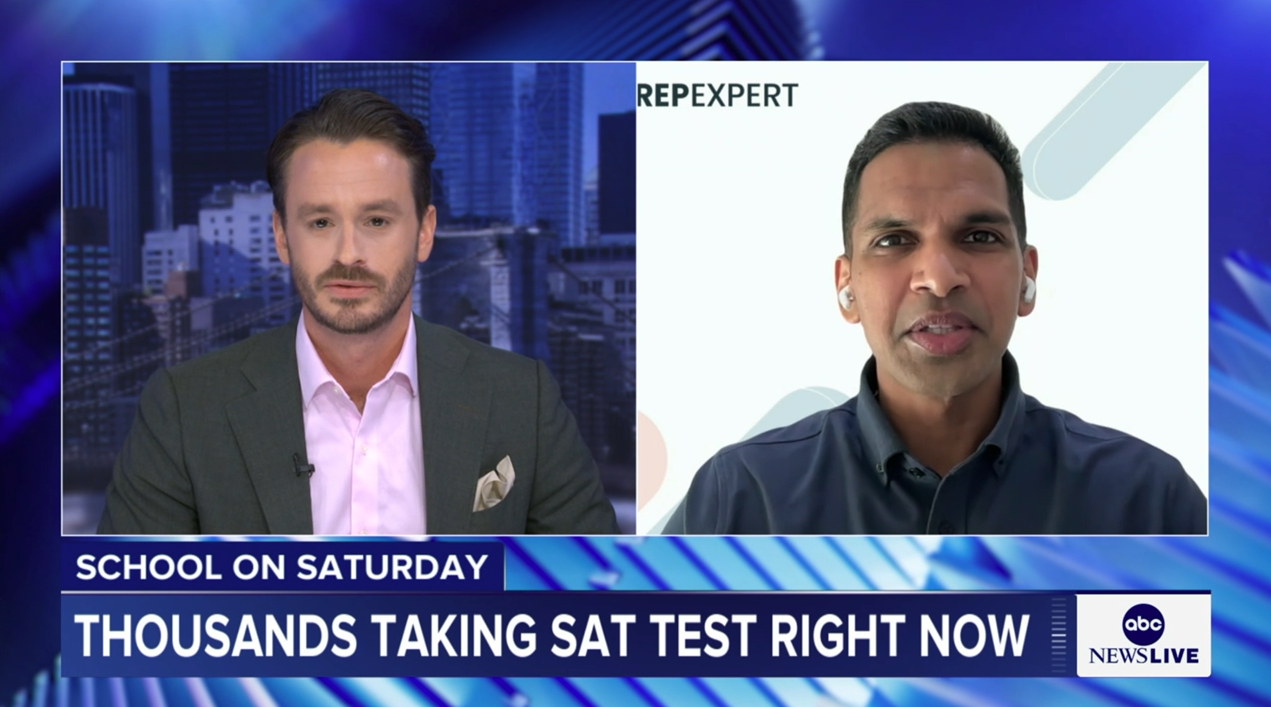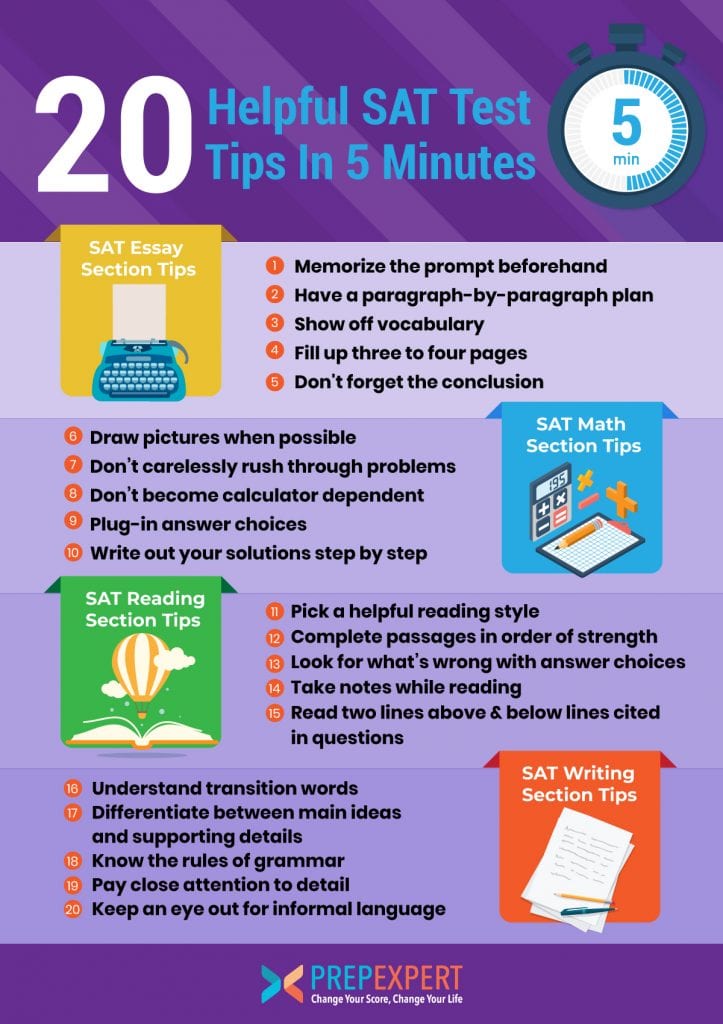20 Helpful SAT Test Tips In 5 Minutes
Once again, everybody loves lists. Everybody loves helpful tips. If you’re thinking about taking the SAT but have no idea how to start preparing for it…then we’ve got you covered here with our own SAT test tips.
Need a place to start preparing for the SAT? Here then are 20 fast and easy SAT test tips to get your prep started.
Learn how to prepare for standardized tests with our year-round SAT prep and ACT prep courses today.
[sat_one]
SAT Essay Section Tips
Memorize The Prompt Beforehand
It’ll save you time for writing.
The SAT Essay prompt is lengthy, taking a lot of time to read. However, after multiple exams now, the prompt is exactly the same.
Work on memorizing the prompt and familiarize yourself with the requirements when doing test prep. When test day arrives, you’ll already have the prompt down, so you can immediately set out to write.
Have A Paragraph-By-Paragraph Plan
By having a plan on your writing prior to the test, you’ll spend more time on other focuses.
Before you start writing, make sure that you have a rough outline of the five essay paragraphs. This will ensure you know exactly what to write next, so your points and transitions are correctly included.
More importantly, you won’t run into any writer’s block. Instead, you can bang out the entire essay and still have just enough time to go back and review for revisions or mistakes. Outline-wise, all you need to have are the following items:
- A developed thesis
- Three supporting points
- Supporting examples for each point
Show Off Vocabulary
Use some elevated vocabulary words in every paragraph.
One way to guarantee a higher score is by using a few advanced vocabulary words per paragraph. When a grader sees you have used advanced words, you will receive credit for your vocabulary. If you only use elevated vocabulary words once or twice in the essay, then there’s a chance they won’t be noticed.
Fill Up Three To Four Pages
Graders equate length with quality.
Studies have shown that students who fill up three to four pages score the most points. Since graders don’t have time to fully read a two-page essay, they’re going to assume that only two pages don’t have much of an argument.
However, when filling up those pages, don’t write so fast that your handwriting becomes illegible. You will lose points automatically if the essay is unreadable.
Don’t Forget The Conclusion
Your essay must contain a concluding paragraph, no exceptions.
Graders want to see five paragraphs— an introduction, three body paragraphs, and a conclusion. Otherwise, they’ll dock points away.
Make sure to leave yourself enough time to write those five paragraphs. Your conclusion doesn’t have to be very long; just make sure that you clearly restate the thesis.
SAT Math Section Tips
Draw Pictures When Possible
Drawing figures saves you time by helping you work out problems more quickly.
Anytime a word problem describes a shape or a figure, draw it out. Drawing out problems helps clarify the necessary steps, in order to solve problems.
This strategy works well for geometry problems, where you’ll be using concepts like SOH CAH TOA and the Pythagorean theorem.
Remember this tip: when a problem does give you a figure or a shape, don’t assume that it’s to scale unless you’re explicitly told so.
Don’t Carelessly Rush Through Problems
Don’t rush to finish all of the questions at the cost of losing points on easy problems.
Because the questions progress in difficulty, many students tend to speed through the section’s earlier, easier questions. The problem is that this rushing often leads to making avoidable mistakes.
Every question has the same point value; screwing up the easy questions while trying to crack the hard ones can lead to losing points on everything.
Instead, go at a deliberate pace. Remember, your goal is getting as many points as possible, not finishing the test early by rushing through questions.
Don’t Become Calculator Dependent
Know how to solve problems without your calculator.
Calculators are incredibly helpful, where you’re allowed to use them. However, if you never write out any of the solution steps, at some point you’re likely to miss an important detail.
Also, you’ll panic if you reach a problem that you don’t know how to solve by hand. Your calculator should be used as an aid, not as a crutch.
Plug-In Answer Choices
If you’re unsure of how to solve a problem, then plug in answer choices to see what works.
In many instances, an answer choice works for the problem’s solution. If so, then that answer choice is correct.
However, only take this step if you don’t know how to solve the problem already. Why? Because plugging in is a time-consuming process that isn’t 100% guaranteed to work every time.
Write Out Your Solutions Step By Step
Write out your solutions step-by-step to prevent simple mistakes.
It’s always best to write out every problem-solving step, even the simple ones. One reason why is that many points are lost due to simple mistakes like incorrect factoring or screwing up a decimal place.
You can also check back and review your work. Go ahead then and write everything out.
SAT Reading Section Tips
Pick A Helpful Reading Style
Choose a passage reading approach that allows you to answer every question in time.
The Reading test’s biggest challenge is timing. The test requires you to read six passages and answer over fifty questions with just over an hour to do it.
You might be able to read all the passages in full and answer every question, without sacrificing time or comprehension. But this is an especially tough task. Instead, you might want to consider skimming.
Skimming involves reading the first and last paragraphs of the passages, in order to determine the passage’s main idea. Then, you read the first sentence of each body paragraph, to decipher each body paragraph’s main point.
Complete Passages In Order Of Strength
Read your strongest passages first.
At the beginning of the Reading test, rank the passages—Fiction, Social Studies, History, and Natural Science—in your order of strength, and complete your best passages first.
If certain passages give you trouble, then you’re likely to miss those associated questions. Save your worst section for last. If you’re not sure which passages are your best and worst, take a few practice tests and review the results.
Also, be mindful that you’re filling in the correct Scantron bubbles with the corresponding passages when skipping around.
Look For What’s Wrong With Answer Choices
Identifying problems with answer choices will help you find the right answer.
On the Reading Test, wrong answers will either be:
- Text taken verbatim from a passage and then edited to be incorrect
- Address a supporting detail rather than the main point
- Make a claim that relies on an assumption
Correct answer choices can always be supported with direct evidence. Never use an assumption to answer a question.
Another way to avoid falling for a wrong answer choice is to read the question, and then come up with your own answer before looking at answer choices. Match the answer that you came up with to the answer choice closest to it. Most times, you’ll be right.
Take Notes While Reading
Taking notes while you read improves focus and strengthens passage understanding.
Note-taking requires active text engagement, so you better understand what you’re reading. You also record the passage’s most important points, which helps when answering questions.
Read Two Lines Above & Below Lines Cited In Questions
For line-specific questions, don’t just read the cited lines in the question.
Make sure you also read two lines above and two below the citation. You will have the proper context for the lines associated with the question.
You need to know context where a word is used, or point is made, in order to understand the significance. Line citations alone don’t provide the full necessary context.
[sat_two]
SAT Writing Section Tips
Understand Transition Words
Transition words provide insight into sentence order and paragraph organization.
The toughest questions require you to rearrange sentence or paragraph order. Conjunctions are a great way to find clues about how to answer these questions.
Conjunctions describe the relationships between words and sentences, so they indicate what information should come before and after.
Differentiate Between Main Ideas And Supporting Details
The main idea is referenced repeatedly throughout a paragraph or passage; supporting details are mentioned only once or twice.
Many test questions require you to identify a paragraph’s main idea or passage or provide supporting details.
The main idea of a paragraph or passage is the point the author is trying to prove. The main idea will be repeatedly referenced. A supporting detail provides evidence for the main idea and is mentioned once or twice.
Recognizing these distinctions will help you answer questions related to the author’s intent, and providing argument support.
Know The Rules Of Grammar
Knowing grammar rules inside and out will help you immensely.
Know various grammar rules:
- Where to place commas and other punctuation marks
- How to place modifying phrases
- Preserve parallelism
- The verb-subject agreement
These tools will ensure that you don’t get any problems wrong in this section. Don’t worry if you didn’t learn these rules in school, or if you’ve practically forgotten them. They’re easy to learn and review over the course of your test prep.
Pay Close Attention To Detail
Pay attention to spelling and grammar details because the test wants to trip you up.
Many Writing test questions boil down to minor details like comma usage or verb tense. If you go too fast when answering questions, then you’ll miss these small details and lose too many easy points.
Make sure then to keep a deliberate pace, and double-check your answer choice before bubbling it in. If you’re not 100% sure and still have time to work on the question, then verify your answer choice again.
Keep An Eye Out For Informal Language
Eliminating informal language helps preserve tone.
The Writing section tests your ability to identify and maintain tone throughout a specific paragraph or entire passage. Every test passage should possess a formal, academic tone.
If you see a slang or colloquial word, then you know that it needs to be replaced with a more formal term. Even when a passage is written from a personal perspective, the writing must retain an academically rigorous structure.
[sat_three]
For more test strategy, college admissions, and scholarship application tips sign up for our FREE class happening right now!
Written by Dr. Shaan Patel MD MBA
Prep Expert Founder & CEO
Shark Tank Winner, Perfect SAT Scorer, Dermatologist, & #1 Bestselling AuthorMore from Dr. Shaan Patel MD MBA

How Prep Expert® Students Achieve Life-Changing ACT & SAT Score Improvements
For thousands of students, the SAT or ACT isn’t just a test — it’s a turning point. A higher score…

How to Get a Good ACT Score
Getting a good ACT score can feel a little mystifying to some students. After all, with the big numbers the…

Tens of Thousands Are Sitting for the SAT—But Only the Savvy Ones See a Massive Opportunity
Why Tens of Thousands of Students Taking the SAT Right Now Should See It as an OpportunityBy Dr. Shaan…
